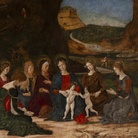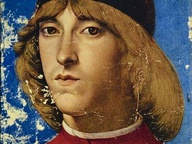Burden of proof The construction of Visual. Evidence from the Holy Shroud to Satellite Images

© Rodolphe A.Reiss, 1925. Collezione dell'Istituto di Polizia Scientifica e di Criminologia di Losanna
From 27 Gennaio 2016 to 01 Maggio 2016
Turin
Place: CAMERA - Centro Italiano per la Fotografia
Address: via delle Rosine 18
Times: 11am-7pm; Thursday 11am-9pm; Tuesday closed
Organizers:
- Patrocinio di:
- MiBACT
- Regione Piemonte
- Città di Torino
Telefono per informazioni: +39.011.0881150
E-Mail info: camera@camera.to
Official site: http://camera.to
The exposition analyses the history of forensic photography and displays a collection of pieces spanning over one hundred years of history: from the first photos appearing in courts of law to the satellite photos used by human rights organisations to report the killing of civilians, like after drone attacks. These powerful photographs are very different from one another but share the terrible violence that they document and substantiate.
CAMERA has selected eleven case studies in order to illustrate a scientific approach to photography as a tool in the hands of justice. Compared to the research conducted in the fine arts field, this one is certainly very different but it does not lack a sort of grim charm, dignified by the weight of history.
Are artistic and forensic photography really that different, though? The former has often questioned the actual verisimilitude between photography and reality, while the latter has made truth seeking and documentation its raison d’être.
This exhibition explores both the power and the limits of photography in the quest for the truth. The image shows its power, more shocking and more convincing than words or figures could ever be. The limit is in the technique: it often disproves the idea that the photographer’s lens is an unerring eye – observing and registering all – that can capture the moment and stop the time.
It becomes clear that the truth is not just reconstructed but is actually built in that moment to be later defended by proofs – among which the images play the main role. Therefore, it is not enough to exhume mass graves of Kurd victims of the genocide committed by the Iraqi army in 1988. In 1992 a photographer from Magnum agency worked with the activists in the search for evidence, and meticulously documented the disinterment in order to prove the existence of those victims so that they could receive justice. Putting the Nazi hierarchs on trial is not enough: the horror of extermination camps was photographed by the Allies following precise rules and the video that followed them was the most important count charged on the accused in Nuremberg. The truth coming out from this evidence is everything but plain: it has been hard to obtain and no image will ever be seen enough times by enough people so that it becomes immortal and safe from historical revisionisms.
In Italian, ‘camera lenses’ have been called “objectives” in hopes that photography would protect us from the imprecision and the doubts of subjectivity. Nevertheless, a photo can have more than one interpretation, and, to this day, dire geopolitical and humanitarian consequences could follow. Are there, or are there not, traces of the ancient Bedouin cemetery of Koreme in the Negev in the aerial photographs taken but the RAF at the end of World War II – before the birth of Israel? The people saying that you cannot see a Bedouin cemetery in the noised and foggy pictures taken 70 years ago are not only arguing about some details in old photos. They are equally stating that the thousands of Palestinian families who still live in the area are squatters that have to be sent away from their homes, and this is an additional proof of the terrible power that pictures can have.
An intense and multi-layered exhibition, that talks about our dark side and our desperate need for certainties.
Exhibition conceived by Diane Dufour.
With Luce Lebart, Christian Delage and Eyal Weizman.
With the contribution of Jennifer L. Mnookin, Anthony Petiteau, Tomasz Kizny, Thomas Keenan and Eric Stover. A coproduction by Le Bal (Paris), Photographers’ Gallery (London) and Netherlands FotoMuseum (Rotterdam).
CAMERA has selected eleven case studies in order to illustrate a scientific approach to photography as a tool in the hands of justice. Compared to the research conducted in the fine arts field, this one is certainly very different but it does not lack a sort of grim charm, dignified by the weight of history.
Are artistic and forensic photography really that different, though? The former has often questioned the actual verisimilitude between photography and reality, while the latter has made truth seeking and documentation its raison d’être.
This exhibition explores both the power and the limits of photography in the quest for the truth. The image shows its power, more shocking and more convincing than words or figures could ever be. The limit is in the technique: it often disproves the idea that the photographer’s lens is an unerring eye – observing and registering all – that can capture the moment and stop the time.
It becomes clear that the truth is not just reconstructed but is actually built in that moment to be later defended by proofs – among which the images play the main role. Therefore, it is not enough to exhume mass graves of Kurd victims of the genocide committed by the Iraqi army in 1988. In 1992 a photographer from Magnum agency worked with the activists in the search for evidence, and meticulously documented the disinterment in order to prove the existence of those victims so that they could receive justice. Putting the Nazi hierarchs on trial is not enough: the horror of extermination camps was photographed by the Allies following precise rules and the video that followed them was the most important count charged on the accused in Nuremberg. The truth coming out from this evidence is everything but plain: it has been hard to obtain and no image will ever be seen enough times by enough people so that it becomes immortal and safe from historical revisionisms.
In Italian, ‘camera lenses’ have been called “objectives” in hopes that photography would protect us from the imprecision and the doubts of subjectivity. Nevertheless, a photo can have more than one interpretation, and, to this day, dire geopolitical and humanitarian consequences could follow. Are there, or are there not, traces of the ancient Bedouin cemetery of Koreme in the Negev in the aerial photographs taken but the RAF at the end of World War II – before the birth of Israel? The people saying that you cannot see a Bedouin cemetery in the noised and foggy pictures taken 70 years ago are not only arguing about some details in old photos. They are equally stating that the thousands of Palestinian families who still live in the area are squatters that have to be sent away from their homes, and this is an additional proof of the terrible power that pictures can have.
An intense and multi-layered exhibition, that talks about our dark side and our desperate need for certainties.
Exhibition conceived by Diane Dufour.
With Luce Lebart, Christian Delage and Eyal Weizman.
With the contribution of Jennifer L. Mnookin, Anthony Petiteau, Tomasz Kizny, Thomas Keenan and Eric Stover. A coproduction by Le Bal (Paris), Photographers’ Gallery (London) and Netherlands FotoMuseum (Rotterdam).
SCARICA IL COMUNICATO IN PDF
COMMENTI

-
 Dal 20 dicembre 2024 al 04 maggio 2025
Fermo | Palazzo dei Priori
Dal 20 dicembre 2024 al 04 maggio 2025
Fermo | Palazzo dei Priori
-
 Dal 20 dicembre 2024 al 04 maggio 2024
Gorizia | Palazzo Attems Petzenstein
Dal 20 dicembre 2024 al 04 maggio 2024
Gorizia | Palazzo Attems Petzenstein
-
 Dal 18 dicembre 2024 al 18 dicembre 2024
Venezia | Museo Correr
Dal 18 dicembre 2024 al 18 dicembre 2024
Venezia | Museo Correr
-
 Dal 14 dicembre 2024 al 02 marzo 2025
Palermo | Palazzo Abatellis
Dal 14 dicembre 2024 al 02 marzo 2025
Palermo | Palazzo Abatellis
-
 Dal 12 dicembre 2024 al 23 febbraio 2025
Roma | Palazzo Altemps
Dal 12 dicembre 2024 al 23 febbraio 2025
Roma | Palazzo Altemps
-
 Dal 13 dicembre 2024 al 31 agosto 2025
Roma | Museo dell'Ara Pacis
Dal 13 dicembre 2024 al 31 agosto 2025
Roma | Museo dell'Ara Pacis


